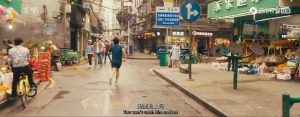CRAZY ALIEN, DIR. NING HAO (2019)
Wenyun Street and North Cai’e Road, Furong District, Changsha
The alien escaped when Geng Hao and Shen Tengfei were quarreling, then the two men started chasing after the running alien. The clip is from Crazy Alien 2019, directed by Ning Hao.
Crazy Alien 2019 is a science-fiction comedy film released during the Chinese Spring Festival. It tells the story of an alien’s adventure on the earth. Coming out in the lunar Chinese New Year, it has to fulfill audience’ expectation to be amusing, exciting and fast-paced. This might be a reason that an old region in Changsha has been selected for film-shooting.
Changsha has always been considered a typical place where people retain close and intimate relationships among communities. Community culture and folk habits are well-preserved. Residents here are familiar with each other and greet with native dialect and nicknames.
Starting from an ally named Wenyun Street to its crossroad with North Cai’e Road, this region sets the context for the interaction between the alien and 2 Chinese men. Before the alien landing on earth, an accident happened to his rocket. He fell into Geng Hao’s home and was captured. On the way to a local clinic, a night view of this community is shown. Most shops are small-size, and the street is narrow. People can talk to each other, standing at their door. Later within the same region comes a tension chasing after the alien, and a more detailed narrative of the presence is given. In the daytime, passengers and cars are flooding. Modern elements are put in a context consists of dilapidated buildings and plastic signs. It contrasts between the new and the old, and one party will eventually take over the other.
On the field trip, I asked for directions from a shop owner. As he said, part of Wenyun Street is under reconstruction and shops are demolished to give way for a metro line. I took pictures of only the left part.
There are not many differences between reality and film scenes. The name of shops, people hanging out, street signages and the whole atmosphere are similar to what is presented in the movie. Shooting techniques are also plain and documentary, without complicity.
Although the vivid community picture perfectly echoes the film atmosphere, the movie itself is not a tourism promotion. The city view is only a background for the story, and it does not matter where exactly the buildings are. Moreover, people in the movie communicate in the Sichuan dialect, which is dominant in Sichuan Province instead of Changsha. Naturally, the audience will take it for granted that the story happened in Sichuan. The significance of the place, Changsha, is detached from the buildings in the movie.
This phenomenon is more and more generally seen in film production. Buildings do not belong to a specific place anymore. They are tools subtracted, placed and used, without identification.
In the movie, an agent is searching for and rescuing the alien. Photos sent by the alien are clues telling where he was. Following these, the agent visited Paris, Egypt and Brazil. It turned out that the alien was prisoned in an amusement park in China, decorated by scaled landmarks from the globe. This is precisely a reflection of the role of buildings in today’s movies. Memories, characters and feelings are fading. It is getting less achievable to travel around the world through movies because you have no idea of whether the Eiffel Tower is in Paris or a studio.
— Wang Huiquan, 3035637515


Top: a photo taken on North Cai’e Road, Changsha, Hunan; Bottom: 2 men are chasing the running alien. Scenes from Crazy Alien, 2019, directed by Ning Hao.


Top: a photo taken on Wenyun Street, Changsha, Hunan. Bottom: 2 men started their chasing. Scenes from Crazy Alien, 2019, directed by Ning Hao.
You highlighted how buildings from a specific place are substracted and attached to places other than the original location as well as the mismatch between place (Changsha) and the dialect (Sichuan) used in the film. Perhaps you could better reflect these phenomena through Ackbar Abbas’ concept of cultural disappearance. Elaborating on the significance of the coherence to the storytelling (between both the buildings and the place as well as the dialect and the place) would help you to enhance your argument. For example, you mentioned how people from Wenyun Street seem to know one another. In what way is this significant to the narrative of the film? You could use these “breadcrumbs” to guide your readers through your arguments. Relating your analysis to one of the key ideas we have discussed in the class will be helpful for you to read through the site and build your argument. Also, remember to cite any others’ works you referred properly. This would include, but not limited to, texts, images and/or videos.